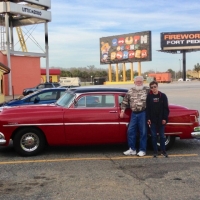54 Jet & Hornet What-Ifs
Mahoning63
Member
in HUDSON
Hi, a few quick image mods exploring changes to proportions while keeping Hudson's good bones. A Packard V8 in '55 would have made a Hornet 4-door hardtop very competitive. If Jet could have been delayed a half year to lower it along lines of what Spring had wanted, and 232/262 fitted, could have been a real pocket rocket, maybe called the new Wasp. Jet would have been saved for upcoming GT picking up some of Italia's styling.




0
Comments
-
Packard was never going to allow Hudson or Nash to have their top line V8. Tthe 320 cuin was put in entry level Packards. The 352 and later 374 cu in V8s were saved for the upper level Packards. Hudson's 308 was almost as powerful, and probably could have been goosed up to exceed the 215HP of the Packard V8 as well. Hudson screwed up by investing in the Jet, which was a poor styling design. Had they taken that money in 1950 and put it into a V8 and redesign of the Hornet they may have had a better shot of survival, and even if a merger had happened in a much stronger negotiating position.0
-
Ken the other thing was the Packards were coming in at about 4,300 lbs., really heavy cars, Hudsons and Nashes were quite a bit lighter with their unibody construction. People always think my Hudson is well over 2 tons, but actually the 1950s were about 3,500 to 3,700 lbs,0
-
Bernie Siegfried told me the initial Jets were build on a 108" wheel base and used either the 232 or 262 engine with an overall length of 185". The "bucks" he called them were highly modified Pacemaker bodies. All was going well until Barit showed the engineering bucks to the then largest dealer they had - Jim Moran of Courtesy Motors in Chicago - Who then went into great detail as to what he thought the car should look like & Barit ordered the changes made at that time. As Always, one bad apple screws up the program for everybody ! ! ! !
0 -
Are you guys able to see the images? I saw them after uploading last night but this morning don't.Too bad nobody got to Barit after the tall Jet took final form. They could have showed the car to a sample of the 95% of volume dealers across the rest of the country, most of whom probably would have said the Chicago guy was crazy, don't listen to him except for the wrapped rear glass. Had they done this in mid or even late-1953, Barit could have delayed the January launch a half year to remove the extra 3-1/2 to 4 inches of sheetmetal below the side glass that Frank Spring probably never wanted.Thought the Packard was heavier too but this is what the Standard Catalog says:1954 Hudson Hornet Special/Hornet - 3560/3620 lbs - 124 wb (manual trans)1955 Packard Clipper Deluxe/Super - 3680/3700 lbs - 122 wb (manual trans)1955 Hudson 308 Six - 160/170 HP1956 Hudson 308 Six - 165/175 HP1955 Packard 320 V8 - 208/225 HP (AMC/Packard)1956 Packard 320 V8 - not offeredToo bad both companies didn't work together more closely in these years, they only needed one family of V8s and one shared body shell, excepting Jet.0
-
It depends on which Packard you are comparing. The 400 for example weighs in at 4,250 from the data I have and it was 127 Wb. It of course carried the 352 in 1955.0
-
First, Barit wanted the Jet to have a high roof line so a man could wear his hat while driving. This same idea almost killed Chrysler as Keller had the same vision.As for the Packard v8: Packard sold de-tuned (lower compression) v8's to AMC with a small 2 barrel carburetor, that featured a single exhaust. In 1956 both Nash and Hudson were offered with the 352 Packard v8. Have a copy of road tests in 1956 that the 352 v8 Hudson kept up with the Desoto hemi and Olds 88 and they both had dual exhausts and four barrel carburators.. Packard did not want AMC cars to out perform their cars as AMC cars were much lighter.As from personal experience, my 1956 Hudson with the 352 v8 has beaten numerous 7x Hornets that were skeptical. Yes, it has the improved twin ultramatic, with the quicker factory gear selector on the quadrant.Recently had the engine rebuilt with the correct higher Packard compression, installed the large Rochester 4 barrel carburetor from the 1956 Packard 374, and it is even faster. Will convert the single exhaust to dual, and it should have an excess of 275 HP.Don't really know if Hudson designed their own v8, if it would have saved the company. Studebaker designed and built their own v8, and how did that work out?0
This discussion has been closed.
Categories
- 36.9K All Categories
- 113 Hudson 1916 - 1929
- 20 Upcoming Events
- 92 Essex Super 6
- 28.6K HUDSON
- 574 "How To" - Skills, mechanical and other wise
- 995 Street Rods
- 151 American Motors
- 178 The Flathead Forum
- 49 Manuals, etc,.
- 78 Hudson 8
- 44 FORUM - Instructions and Tips on using the forum
- 2.8K CLASSIFIEDS
- 608 Vehicles
- 2.2K Parts & Pieces
- 77 Literature & Memorabilia
- Hudson 1916 - 1929 Yahoo Groups Archived Photos

